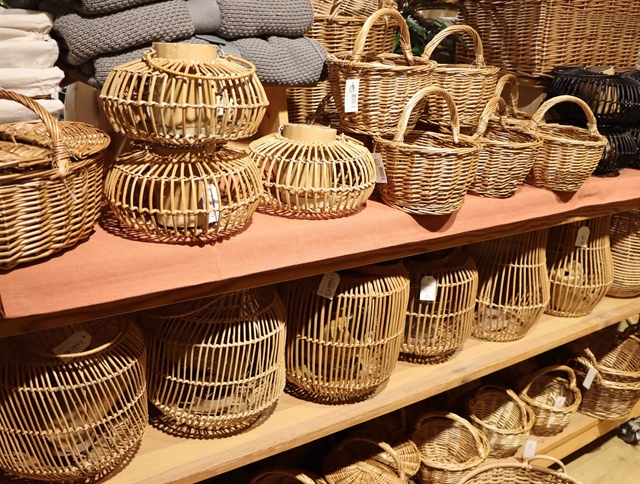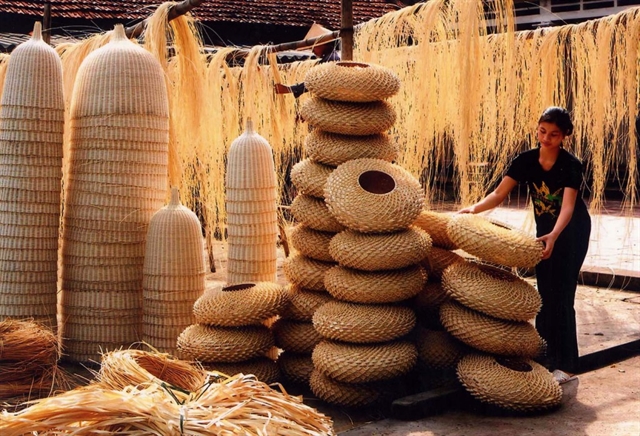Weather:
- Ha Noi 33oC
- Da Nang 30oC
- Ho Chi Minh 33oC

One of the decisive factors for Việt Nam's handicraft industry to develop sustainably and reach US$6 billion export revenue by 2030 is the development of sustainable raw material resources. Việt Nam News reporter Tố Như talks to Lê Bá Ngọc, vice chairman of the Việt Nam Handicraft Exporters Association (Vietcraft), about the issue.
Inner Sanctum: How bad is the raw material shortage facing Vietnamese craft villages?
In reality, the problem of raw material shortage does not properly reflect the current situation of craft villages.
Việt Nam faces both shortages and surpluses, or more accurately, the raw material resources for the handicraft industry are unstable. There is a severe shortage of many essential materials, particularly rattan.
The handicraft industry aims to achieve an export value of $6 billion by 2030. To reach this goal, Việt Nam would need 100,000 tonnes of rattan. However, our rattan is now estimated at only about 40,000 tonnes.
There are certain materials that are both in shortage and surplus, like with sedge, that largely depend on the Chinese market.
When China makes large purchases, we have a shortage of sedge, and when their purchases decrease, we end up having a surplus. This clearly reflects the instability of Việt Nam’s raw material resources.
Việt Nam has a substantial supply of bamboo, approximately from 1.5 million hectares of bamboo forests, indicating that we are not short of material in wickerwork production. However, we are now in short supply of fishpole bamboo.
Therefore, the story of our raw material resources is primarily characterised by instability rather than a simple matter of scarcity.
Inner Sanctum: What recommendations do you have for the authorities in developing raw material resources?
The Vietnamese handicraft industry now has an export revenue of about $3 billion per year. The Ministry of Agriculture and Rural Development is working towards accessing the value chain, with a primary focus on addressing the issue of raw materials.
However, it is necessary to have an innovative approach to achieve sustainable development. For example, collaborative efforts between government agencies and businesses in developing plans and leveraging their roles. Businesses should be key actors in this value chain, working together with the government to bring about effective change.
In addition, it is crucial to quickly respond to the changing demands of the international market, as the global market is constantly evolving. At present, the international market demands transparency in the origin of raw materials to avoid issues such as deforestation and illegal exploitation. These are legitimate requirements that the government is pursuing.
Market requirements are changing rapidly. Customers now demand proof of origin for raw materials, and by December, many buyers may stop purchasing goods from Việt Nam if their materials do not have a verifiable source.
The active participation and collaboration of relevant ministries, departments, and agencies, along with businesses, are therefore crucial to addressing this issue.
For example, if we need 10,000 hectares of certified forest for rattan cultivation, it is essential to take immediate action. With determination, it would take between 15 and 18 months to establish this resource area.

Inner Sanctum: To handle the scarcity issue, should Việt Nam handicraft industry import essential materials like rattan from abroad?
In trade, it is crucial to proactively secure the source of materials and preserve the export value for the country.
Việt Nam is an agricultural country with abundant bamboo. However, due to unplanned exploitation, our bamboo resource is gradually depleting.
But the importation of materials is not encouraged. Many countries have banned exporting raw materials and instead focusing on exporting value-added products. Moreover some countries like Indonesia and Laos have banned the export of rattan as raw materials.
As a result, we must focus on developing domestic material resources to not only take a proactive approach in producing goods for export, but also to generate incomes and work for farmers, particularly in rural and mountainous areas.
The natural conditions in Việt Nam are highly suitable for rattan cultivation in various regions. The country has the third-largest rattan source in the world, following Indonesia and Malaysia.
The main rattan areas in Việt Nam are concentrated in forests in the provinces of Quảng Nam, Quảng Ngãi, Thừa Thiên Huế, and Lâm Đồng.
Rattan is also planted in the northern provinces of Hưng Yên, Thái Bình and Hòa Bình. If we have a comprehensive plan and establish strong supply chain linkages, we can develop a sustainable raw material resource for our handicraft sector.

Inner Sanctum: What do you think of the potential of Vietnamese handicrafts?
Việt Nam has great potential in developing its handicraft industry - the wide range of materials of an agricultural country, the high skills of artisans that have been fostered through generations, and the cultural diversity of the 54 ethnic communities all play a big part.
I firmly believe that with proper investment, the export turnover of Việt Nam’s handicraft sector may surpass the above-said target of $6 billion to $10 billion in 2030, with an annual growth rate of 30 per cent. VNS


